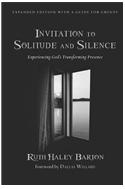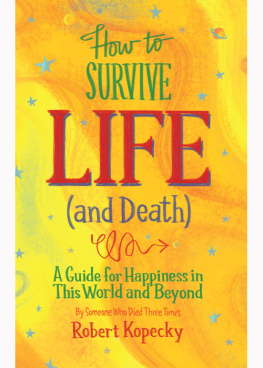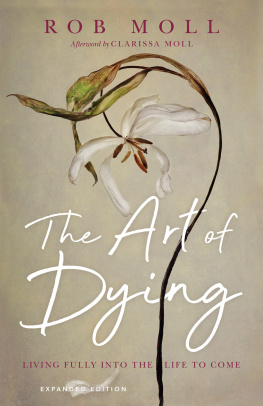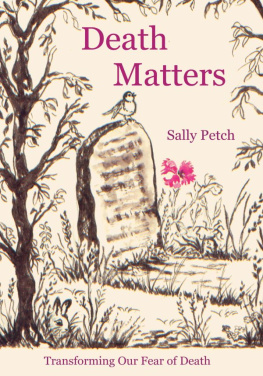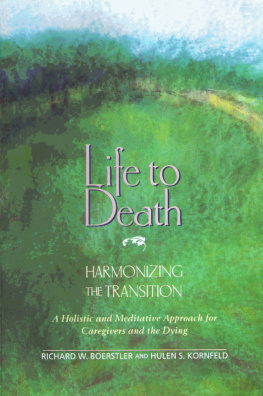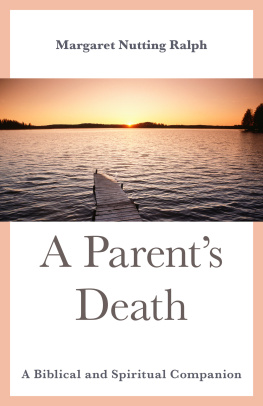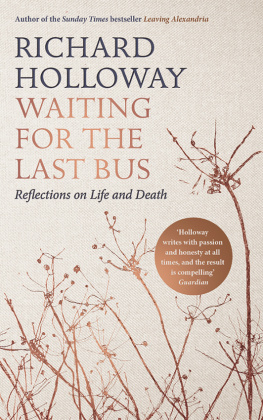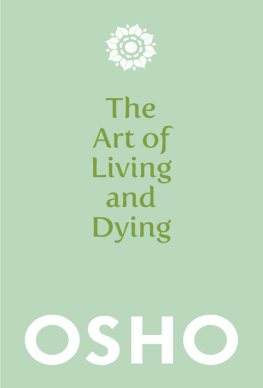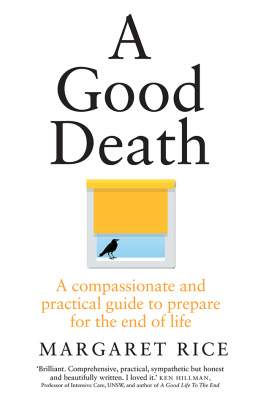Contents
Guide

The author and publisher have provided this e-book to you for your personal use only. You may not make this e-book publicly available in any way. Copyright infringement is against the law. If you believe the copy of this e-book you are reading infringes on the authors copyright, please notify the publisher at: us.macmillanusa.com/piracy.
This book is dedicated to the men, women, and children who gave me the blessing of being with their dying. My true teachers.
And
to Stephen Levine, heart friend.
All tempest has, like a navel, a hole in its middle,
through which a gull can fly in silence.
HAROLD WITTER BYNNER
As a physician, I was taught that death was lifes opposite, a physical event marked by specific physiological changes. I was trained to manage the dying, to prolong life whenever possible, and to control pain and suffering when it was not. The pain of survivors was hardest to manage, but in time, most people took comfort in the thought of an afterlife and found a way to move on. Despite a great many experiences with those who were dying or who died, I and my fellow professionals had little or no emotional reaction to death and certainly no curiosity about it. Such curiosity would have been seen as morbid. The idea that death might offer the living something vitally important would have been perceived as simply bizarre. In a less extreme form, our professional stance was a reflection of a culture-wide attitude toward death and the dying.
This is the environment in which Frank Ostaseski began his courageous and pioneering work, and first offered his genius of seeing each death as unique and meaningful, as an opportunity for wisdom and healingnot only for the dying, but also for those who live on. The great depth of experience he brings to this book can only be accumulated by those who are fearless, who have found their way to stillness and presence, who possess an ability to connect to the heart and soul of others, and who are blessed with the gift of story for sharing the road traveled. The Five Invitations is filled with stories so profound that they function as a compass, a way to travel an unknown road to a desired destination. Many of the true stories in this book can be read as parables, wisdom stories that enable us all to live more purposefully and wisely in many diverse circumstances.
I first encountered death at the time I was born. I weighed 2.1 pounds and spent the first six months of my life between worlds, in an incubator, untouched by human hands. I encountered death again at fifteen, when my chronic illness declared itself in the night and I was rushed unconscious to a hospital in New York City, where I spent almost a year in a coma. Most of the people I know well I have met on the edge between life and death, magnetized there as I have been by the deep wish to glimpse what is most real. Frank Ostaseski is one of these peoplemy colleague, my fellow traveler, my teacher. In The Five Invitations , he has written a beautiful book about life on the edgeabout all of life, reallyand invited us to join him in the space between the worlds. To sit at the table of unknowing. To wonder together. To become wise.
My grandfather was a Kabbalist and by nature a mystic. For him, life was a constant dialogue with the soul of the world. All events were doorways, and the world revealed itself constantly. He was able to see the most profound of realizations in the most ordinary of occurrences. Most of us do not have this gift. We need something larger, something that stops us in our habits of seeing and hearing with more authority, something that challenges our habitual perceptions and ways of thinking in order to recognize the true nature of things. Death is one such doorway. Awareness is the great gift of death. For many people, authentic life starts at the time of deathnot our own death, but someone elses.
Simply put, the nature of life itself is holy. We are always on holy ground. Yet this is rarely a part of our daily experience. For most of us, the sacred shows up like a flash of lightning, a sharp inhalation between one unnoticed breath and the next. The daily fabric that covers what is most real is commonly mistaken for what is most real until something tears a hole in it and reveals the true nature of the world. Yet the invitation to become aware is commonplace. In his brilliant book Small Is Beautiful , E. F. Schumacher suggests that we can see only what we have grown an eye to see. He proposes that the endless debate about the nature of the world is not about differences but simply about the differing capacity of our eyes.
The book that you are holding offers simple, powerful practices to enable you to see what is most real in the midst of what is most familiar. It is an opportunity to see beyond the ordinary. Unlike many books about death and dying presently available, this book is not about a theory or a cosmologyeither traditional or personal. It is not someones ideas or beliefs about what the experience of dying is and means. This book is a sharing of deep experience by a superbly aware observer. It invites you to grow your eyes.
My grandfather taught me that a teacher is not a wise man, but a pointing finger directing our attention to the reality that surrounds us. Frank Ostaseski is such a teacher. This book will remind you of many things. It has reminded me of how few things really matter and how much they matter. How often we go spiritually hungry in the midst of plenty, and how many, many teachers surround us, patiently offering all that we need in order to live wisely and well. I am reminded that death, like love, is intimate, and that intimacy is the condition of the deepest learning. I am reminded, too, of the simplicity of the true teacher, and the power of story to include us in a web of connection far more profound than the superficial things that divide us. Lastly, I am reminded that we are all invited to the dance. I feel a deep gratitude for the invitation to participate fully in life, which is so graciously offered here. So will you.
Ultimately, death is a close and personal encounter with the unknown. Many of those who have died and been revived by the skills of science tell us that the experience has revealed to them the purpose of life. This is not to become wealthy or famous or powerful. The purpose of every life is to grow in wisdom and learn to love better. If this is your purpose, then The Five Invitations is the book for you.
R ACHEL N AOMI R EMEN , M.D.
Author of Kitchen Table Wisdom and My Grandfathers Blessings
Love and death are the great gifts that are given to us;
mostly, they are passed on unopened.
RAINER MARIA RILKE
Life and death are a package deal. You cannot pull them apart.
In Japanese Zen, the term shoji translates as birth-death. There is no separation between life and death other than a small hyphen, a thin line that connects the two.
We cannot be truly alive without maintaining an awareness of death.
Death is not waiting for us at the end of a long road. Death is always with us, in the marrow of every passing moment. She is the secret teacher hiding in plain sight. She helps us to discover what matters most. And the good news is we dont have to wait until the end of our lives to realize the wisdom that death has to offer.
Over the past thirty years, I have sat on the precipice of death with a few thousand people. Some came to their deaths full of disappointment. Others blossomed and stepped through that door full of wonder. What made the difference was the willingness to gradually live into the deeper dimensions of what it means to be human.


